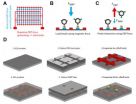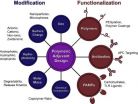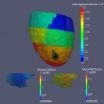(Press-News.org) San Francisco, CA, April 2, 2014 – Eyedrops administered to infants as part of routine outpatient retinopathy of prematurity (ROP) screening can have life-threatening consequences. A case report published in the current issue of the Journal of the American Association for Pediatric Ophthalmology and Strabismus (AAPOS) describes cardiopulmonary arrest in a 27-week-old infant following administration of three sets of cyclopentolate 0.2%/phenylephrine 1% (Cyclomydril) eyedrops.
"Cardiopulmonary arrest can occur from just instillation of eyedrops in a premature infant seen for ROP in an outpatient setting, and pediatric ophthalmologists should be prepared to handle such an emergency in their office," says Sylvia Kodsi, MD, Professor of Ophthalmology at Hofstra North Shore-LIJ School of Medicine. "This can be particularly perilous in outpatient offices where patient monitoring and emergency back-up is not as readily available as in the hospital setting."
Retinopathy of prematurity is one of the most common causes of impaired vision in children and can lead to severe visual impairment and blindness. ROP primarily affects premature infants who weigh 2.75 pounds or less who are born before 31 weeks of gestation. Each year, about 28,000 infants in the U.S. fall into this category and about half are affected to some degree by ROP. About 400-600 of these children with ROP become legally blind. ROP occurs when babies are born before blood vessels in the eye have had a chance to reach the edges of the retina. Abnormal blood vessels form, resulting in inadequate blood supply, retinal scarring, and retinal detachment.
Professional organizations such as the American Association for Pediatric Ophthalmology and Strabismus, American Academy of Pediatrics, and American Academy of Ophthalmology recommend that at-risk infants be regularly screened for changes associated with ROP. To conduct the examination, eyedrops are administered to dilate the pupil (mydriasis) and reduce eye movements by temporarily paralyzing eye muscles (cycloplegia).
In the case that was reported, a 27-week-old low-birth-weight infant presented for a follow-up ROP screening examination at 41 weeks' corrected gestational age. The patient had previously undergone several such examinations, beginning at 30 weeks' corrected gestational age and every 2 weeks thereafter. For all those examinations, the infant received three sets (one drop per eye) of Cyclomydril, a combination of cyclopentolate (an anticholinergic that blocks pupillary constriction and eye muscle contraction) and phenylephrine (an alpha-adrenergic agent that causes mydriasis).
Fifteen minutes after the last set of drops was administered, but prior to the eye examination, the baby suffered a cardiopulmonary arrest and was revived within a few minutes. After transport to the hospital, she experienced another episode of apnea (breathing difficulty) and bradycardia (slow heart rhythm) and was found to have new-onset pulmonary hypertension.
These serious events are most likely attributed to an adverse drug reaction to cyclopentolate. According to co-author Jung M. Lee, MD, an ophthalmology resident also affiliated with Hofstra North Shore-LIJ School of Medicine, the phenylephrine would have mostly been cleared by the time the patient experienced the second event of apnea and bradycardia three hours after instillation of the eyedrops. She cautions that other anticholinergic drugs such as tropicamide may have a similar side effect profile. For this child, subsequent dilated ROP examinations performed with tropicamide 1% and phenylephrine 2.5% were performed without incident.
"Eyedrops used for mydriasis and cycloplegia can be systemically absorbed and cause serious side effects, including oxygen desaturation, apnea, bradycardia, transient hypertension, delayed gastric emptying, and transient paralytic ileus. These effects can be more serious in infants because of their lower body mass and immature cardiovascular and nervous systems," cautions Dr. Kodsi. "Pediatric ophthalmologists should be equipped to handle this type of emergency, either personally or with ancillary services that are immediately available."
INFORMATION: END
Report documents cardiopulmonary arrest in premature infant after cyclomydril eyedrops
Ophthalmologists should be prepared for life-threatening reactions during retinopathy of prematurity screening, cautions a case report published in the Journal of AAPOS
2014-04-03
ELSE PRESS RELEASES FROM THIS DATE:
Drawing conclusions
2014-04-03
Is a picture worth only a thousand words? According to Dr. Carmit Katz of Tel Aviv University's Bob Shapell School of Social Work, illustrations by children can be a critical tool in forensic investigations of child abuse.
Dr. Katz's study, published in Child Abuse and Neglect, compared the results when child abuse victims were offered the opportunity to draw during questioning with victims not offered this opportunity. Her findings saw a significant difference, suggesting a therapeutic value and indicating that children empowered to draw pictures about their abuse provided ...
Radium-223 dichloride in prostate cancer: Major added benefit for certain patients
2014-04-03
Radium-223 dichloride (radium-223 for short, trade name: Xofigo) has been approved since November 2013 for men with advanced prostate cancer, in whom hormone blockade is no longer effective, and symptomatic bone metastases, but without visceral metastases. In an early benefit assessment pursuant to the Act on the Reform of the Market for Medicinal Products (AMNOG), the German Institute for Quality and Efficiency in Health Care (IQWiG) examined whether this new drug offers an added benefit over the appropriate comparator therapy specified by the Federal Joint Committee (G-BA).
No ...
Nanoparticles cause cancer cells to self-destruct
2014-04-03
Using magnetically controlled nanoparticles to force tumour cells to 'self-destruct' sounds like science fiction, but could be a future part of cancer treatment, according to research from Lund University in Sweden.
Watch video:https://www.youtube.com/watch?v=vos0QW2Yclk&feature=youtu.be
"The clever thing about the technique is that we can target selected cells without harming surrounding tissue. There are many ways to kill cells, but this method is contained and remote-controlled", said Professor Erik Renström.
The point of the new technique is that it is much more ...
Tiny power generator runs on spit
2014-04-03
Saliva-powered micro-sized microbial fuel cells can produce minute amounts of energy sufficient to run on-chip applications, according to an international team of engineers.
Bruce E. Logan, Evan Pugh Professor and Kappe Professor of Environmental Engineering, Penn State, credited the idea to fellow researcher Justine E. Mink. "The idea was Justine's because she was thinking about sensors for such things as glucose monitoring for diabetics and she wondered if a mini microbial fuel cell could be used," Logan said. "There is a lot of organic stuff in saliva."
Microbial ...
Attracting wild bees to farms is a good insurance policy
2014-04-03
EAST LANSING, Mich. -- Investing in habitat that attracts and supports wild bees in farms is not only an effective approach to helping enhance crop pollination, but it can also pay for itself in four years or less, according to Michigan State University research.
The paper, published in the current issue of the Journal of Applied Ecology, gives farmers of pollination-dependent crops tangible results to convert marginal acreage to fields of wildflowers, said Rufus Isaacs, MSU entomologist and co-author of the paper.
"Other studies have demonstrated that creating flowering ...
Pulmonary hypertension deaths have increased over past decade according to CDC report in CHEST
2014-04-03
Deaths from pulmonary hypertension have increased over the past decade, according to a study from the Centers for Disease Control and Prevention (CDC).
In the study, published online in CHEST, researchers analyzed death rates from the National Vital Statistics System and data from the National Hospital Discharge Survey between 2001 and 2010 to analyze trends in hospitalizations and death rates related to pulmonary hypertension.
Pulmonary hypertension is characterized by increased blood pressure in the pulmonary arteries, causing the right side of the heart to work ...
Tiny biomolecular tweezers studying force effect of cells
2014-04-03
A new type of biomolecular tweezers could help researchers study how mechanical forces affect the biochemical activity of cells and proteins. The devices — too small to see without a microscope — use opposing magnetic and electrophoretic forces to precisely stretch the cells and molecules, holding them in position so that the activity of receptors and other biochemical activity can be studied. Arrays of the tweezers could be combined to study multiple molecules and cells simultaneously, providing a high throughput capability for assessing the effects of mechanical forces ...
Enhancing the immune response through next generation polymeric vaccine adjuvants
2014-04-03
The great success of vaccines over the past two centuries as a preventive medicine has led to a significant reduction in morbidity and death caused by controllable infectious diseases. The effectiveness of vaccines is dependent on their ability to induce a protective immune response in recipients. Adjuvants, such as aluminum salts, have been integrated into vaccines for more than 70 years to augment the body's immune response to patho-gens. Adjuvants are especially necessary to boost the immune response for subunit vac-cines. However, conventional adjuvants are limited ...
Diffeomorphometry and geodesic positioning systems for human anatomy
2014-04-03
A team of researchers from the Center for Imaging Science at the Johns Hopkins University and the CMLA of the École Normale Supérieure Cachan have demonstrated new algorithmic technologies for the parametric representation of human shape and form. Coupled with advanced imaging technologies, this presents opportunities for tracking soft-tissue deformations associated with cardiovascular studies, radiation treatment planning in Oncology, and neurodegenerative brain illnesses. The software algorithms provide tools for basic science and pre-clinical investigations for synchronizing ...
Structural insights into the inner workings of a viral nanomachine
2014-04-03
Researchers at the Virginia Tech Carilion Research Institute (VTCRI) are using new nanoscale imaging approaches to shed light on the dynamic activities of rotaviruses, important pathogens that cause life-threatening diarrhea in young children. Once a rotavirus enters a host cell, it sheds its outermost protein layer, leaving behind a double-layered particle (DLP). These DLPs are the form of the virus that produces messenger RNA molecules, which are critical for launching the infection.
Researchers, Deborah Kelly, Ph.D. and Sarah McDonald, Ph.D., both Assistant Professors ...
LAST 30 PRESS RELEASES:
Nanoplastics have diet-dependent impacts on digestive system health
Brain neuron death occurs throughout life and increases with age, a natural human protein drug may halt neuron death in Alzheimer’s disease
SPIE and CLP announce the recipients of the 2025 Advanced Photonics Young Innovator Award
Lessons from the Caldor Fire’s Christmas Valley ‘Miracle’
Ant societies rose by trading individual protection for collective power
Research reveals how ancient viral DNA shapes early embryonic development
A molecular gatekeeper that controls protein synthesis
New ‘cloaking device’ concept to shield sensitive tech from magnetic fields
Researchers show impact of mountain building and climate change on alpine biodiversity
Study models the transition from Neanderthals to modern humans in Europe
University of Phoenix College of Doctoral Studies releases white paper on AI-driven skilling to reduce burnout and restore worker autonomy
AIs fail at the game of visual “telephone”
The levers for a sustainable food system
Potential changes in US homelessness by ending federal support for housing first programs
Vulnerability of large language models to prompt injection when providing medical advice
Researchers develop new system for high-energy-density, long-life, multi-electron transfer bromine-based flow batteries
Ending federal support for housing first programs could increase U.S. homelessness by 5% in one year, new JAMA study finds
New research uncovers molecular ‘safety switch’ shielding cancers from immune attack
Bacteria resisting viral infection can still sink carbon to ocean floor
Younger biological age may increase depression risk in older women during COVID-19
Bharat Innovates 2026 National Basecamp Showcases India’s Most Promising Deep-Tech Ventures
Here’s what determines whether your income level rises or falls
SCIE indexation achievement: Celebrate with Space: Science & Technology
Children’s Hospital Colorado performs region’s first pediatric heart and liver dual organ transplant
Australian team discover why quantum computers have memory problems over time
What determines the fate of a T cell?
Candida auris: genetic process revealed which could be treatment target for deadly fungal disease
Groundbreaking discovery turns household plastic recycling into anti-cancer medication
Blocking a key inflammatory pathway improves liver structure and vascular function in cirrhosis, study finds
Continuous spread: Raccoon roundworm detected in nine European countries
[Press-News.org] Report documents cardiopulmonary arrest in premature infant after cyclomydril eyedropsOphthalmologists should be prepared for life-threatening reactions during retinopathy of prematurity screening, cautions a case report published in the Journal of AAPOS





